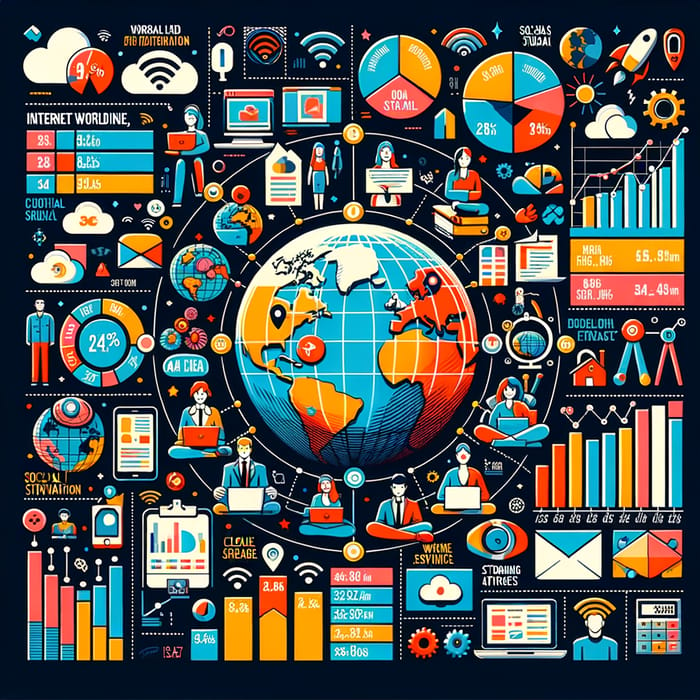The internet has revolutionized the way we form opinions, consume information, and engage in discussions. No longer are we limited to traditional media outlets with gatekeepers dictating the flow of information - today, anyone with an internet connection can share, challenge, or reinforce ideas, influencing everything from personal beliefs to global movements.
While the internet has democratized information, it has also introduced new challenges in how we form opinions. The digital world fosters viral content, creates echo chambers, and accelerates misinformation, making it crucial to understand how online platforms shape our thinking in today’s hyper-connected society.

The Power of Digital Influence
The internet’s influence on opinions is not random - it’s driven by algorithms and design. Social media platforms curate content based on users’ browsing history and preferences, creating a personalized experience that keeps us engaged. This design leads to filter bubbles, where users are exposed primarily to information that reinforces their existing beliefs, making it harder to encounter differing viewpoints.
Simultaneously, viral content on platforms like Twitter, TikTok, and YouTube can shape public opinion at lightning speed. A single tweet, video, or meme can quickly gain traction, influencing political decisions, social movements, and even consumer behavior. The internet’s instantaneous nature means opinions are formed, debated, and solidified faster than ever before, often without the opportunity for deep analysis.
Some key factors shaping opinions online include:
- Social validation – Likes, shares, and comments create a sense of consensus, making certain ideas seem more popular or credible.
- Selective exposure – People tend to engage with content that aligns with their views, reinforcing biases.
- Short-form content – Platforms like Twitter and TikTok simplify complex topics into bite-sized, easily digestible formats, which can reduce the depth of discussions.
- Memes and satire – Humor and exaggeration often shape how people perceive real-world issues, sometimes blurring the line between fact and opinion.
The Role of Social Media in Opinion-Shaping
Social media platforms have become the primary space for public discourse, offering both opportunity and risk in how opinions are shaped. Platforms like Facebook, Instagram, and TikTok give individuals and groups the ability to connect, share, and advocate for causes or ideas on a global scale.
However, social media also has significant drawbacks:
- Polarization – The rapid spread of information, both true and false, can create divisions between groups with opposing viewpoints.
- Misinformation – The ease of sharing content, combined with algorithmic prioritization of engaging posts, can lead to the widespread dissemination of false information.
- Echo chambers – Algorithms that suggest content based on past behavior often result in users only seeing posts that align with their views, reinforcing biases and limiting exposure to diverse perspectives.
The Business of Opinion-Shaping
The internet’s ability to shape public opinion is also a highly lucrative business. Companies, governments, and political parties have learned to harness the power of digital marketing, social media influencers, and targeted advertising to influence perceptions and sway public opinion.
Some strategies include:
- Astroturfing – Creating the illusion of grassroots support for a particular cause, movement, or political ideology.
- Bot-driven engagement – Artificial accounts that artificially inflate support for certain ideas, spreading content and making it seem more popular than it is.
- Targeted ads – Ads that are tailored to individuals based on their online behavior, subtly guiding opinions and actions.
The Challenge of Online Polarization
While the internet allows for a wider exchange of ideas, it has also deepened societal divisions. The rise of online tribalism has led to individuals aligning more strongly with digital communities and echo chambers than with shared real-world experiences.
This digital polarization manifests in various ways:
- Ideological segregation – People increasingly surround themselves with like-minded individuals, further strengthening their existing views.
- Cancel culture – The pressure to conform or face online backlash discourages open discussion and the exchange of differing perspectives.
- Fake news cycles – The speed at which content spreads online makes it difficult to verify facts before a narrative takes hold.
Building Critical Thinking in the Digital Age
As the internet continues to shape our opinions, developing media literacy and critical thinking is more important than ever. To avoid being swayed by misleading narratives, individuals can:
- Diversify information sources – Seek out a variety of viewpoints to challenge existing beliefs.
- Fact-check before sharing – Use fact-checking tools and reputable sources to verify information before sharing it.
- Be mindful of emotional triggers – Many viral posts are designed to provoke strong emotional reactions, which can cloud judgment.
- Engage with long-form content – In-depth articles, books, and expert discussions provide more context and depth, counteracting the oversimplification of complex topics.
The Takeaway
The internet has fundamentally transformed the way we form and share opinions. It has opened up new avenues for communication and idea exchange, but also introduced challenges like echo chambers, misinformation, and rapid polarization. Navigating the modern digital landscape requires critical thinking, media literacy, and the ability to recognize the impact of digital platforms on our beliefs and decisions.
As the internet continues to evolve, those who can engage with digital content critically and responsibly will be better equipped to understand the world, form independent opinions, and participate in more meaningful discussions. The internet isn’t just a tool for communication, it’s a powerful force shaping public opinion on a global scale.